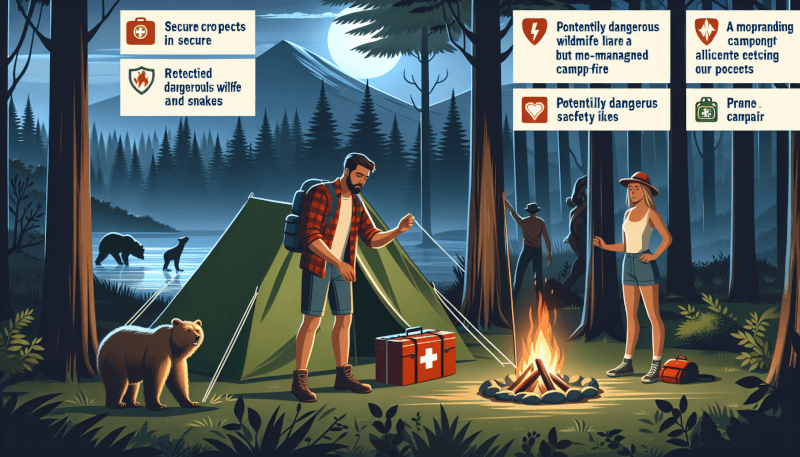Planning a camping trip? Before you head out into the great outdoors, it’s important to ensure your adventure is both thrilling and safe. In this article, discover the top camping safety tips that will guarantee a secure experience. From choosing the right campsite to packing essential safety gear, these tips will help you stay protected and make the most of your outdoor excursion. So, grab your tent and get ready for an unforgettable adventure filled with peace of mind.
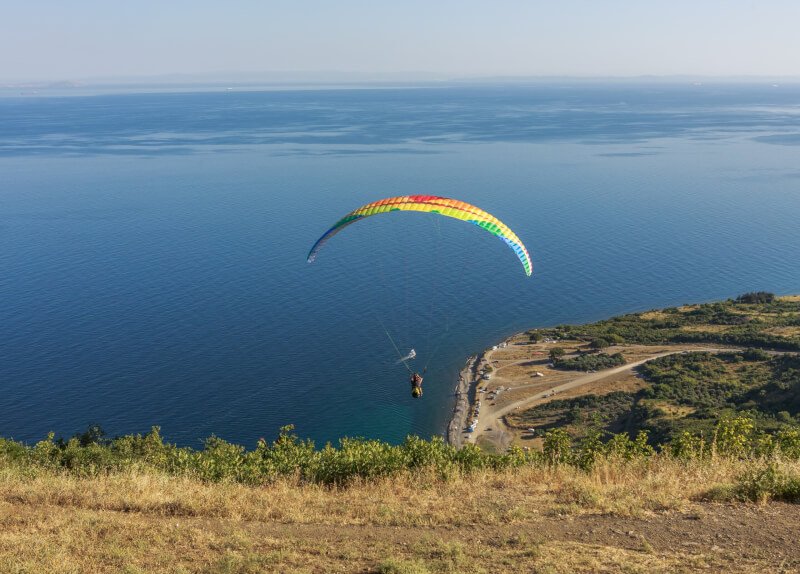
Campsite Selection
When planning a camping trip, one of the first things you’ll need to consider is where you’ll be setting up camp. Researching potential campsites is an important step in ensuring a safe and enjoyable experience. Look for campgrounds in your desired location and read reviews from previous campers to get an idea of what to expect. Consider factors such as the availability of amenities, proximity to certain attractions or activities, and the overall atmosphere of the campground.
Accessibility is another crucial aspect to consider when choosing a campsite. If you or any of your companions have mobility issues, make sure to select a campsite that is easily accessible. Look for campsites that have paved paths or accessible facilities such as restrooms and showers. It’s also a good idea to check if the campground offers any accessible activities or attractions.
Weather conditions can greatly impact your camping experience, so it’s important to take them into account when selecting a campsite. Before heading out, check the weather forecast for your chosen location. Be prepared for any potential changes in weather and make sure you have appropriate gear and clothing. Avoid camping in areas that are prone to extreme weather conditions such as heavy rain or storms.
Lastly, consider the availability of nearby facilities when choosing a campsite. It’s always convenient to have amenities such as restrooms, showers, and drinking water nearby. Some campgrounds may also offer facilities like picnic areas, swimming pools, or playgrounds. Depending on your preferences and needs, prioritize campsites that offer the facilities you consider essential for a comfortable camping experience.
Preparing for Your Trip
Once you’ve chosen the perfect campsite, it’s time to start preparing for your camping trip. Checking the weather forecast is an essential step in planning your trip. Knowing what to expect weather-wise will help you pack the right gear and clothing. Make sure to bring rain gear if rain is in the forecast, and pack warm clothing for colder temperatures during the night.
Creating a detailed itinerary will help ensure that everything goes smoothly during your camping trip. Plan out each day, including activities, meals, and rest times. Consider any specific attractions or hikes you want to visit and make note of their opening hours or any permits required. Having an itinerary will not only help you stay organized but also enhance your overall camping experience.
Informing others of your plans is crucial for your safety when camping. Share your itinerary with a trusted friend or family member who is not joining you on the trip. Provide them with information about your campsites, hiking routes, and estimated return dates. In case of any unexpected incidents, this will allow someone to know where you are and when to expect your return.
Packing essential safety gear is vital for any camping adventure. Your safety gear may vary depending on the activities you’ll be participating in, but some essentials include a first aid kit, a flashlight, a multi-tool, and a whistle. Consider bringing a fire extinguisher if allowed in your campgrounds. It’s also a good idea to have a fully charged portable power bank for emergencies.
Setting Up Your Campsite
Now that you’ve arrived at your campsite, it’s time to set up camp. Choosing a level and stable ground is important for a comfortable night’s sleep. Look for an area without any noticeable slopes or uneven terrain. Avoid setting up camp in low-lying areas that may be prone to flooding if there is heavy rain.
Before setting up your tent, clear the area of any hazards. Remove any rocks, branches, or other debris that could potentially damage your tent or cause injuries. Check the ground for any sharp objects that might puncture your tent floor. Additionally, be mindful of any nearby poisonous plants and avoid touching them.
Setting up proper fire safety measures is essential when camping. If campfires are permitted, use designated fire rings or pits to contain the fire. Keep a safe distance from trees and overhanging branches to prevent accidental fires. Have a bucket of water or sand nearby to extinguish the fire if needed. Always follow the campground’s rules and regulations regarding campfires.
Once your campsite is set up, it’s important to secure your tent and belongings. Make sure your tent is properly staked and secured to withstand any potential wind or rain. Keep your belongings organized inside the tent and store valuable items in a secure location. If you’re leaving the campsite unattended, consider locking your tent or keeping valuables in your vehicle.
Campfire Safety
Campfires are a beloved part of camping, but it’s important to practice campfire safety to prevent accidents. Always follow the campground’s rules and regulations regarding campfires. If there are designated fire rings or pits, use them to contain your fire. This helps prevent the fire from spreading and keeps it under control.
Keeping a safe distance from trees and overhanging branches is crucial to prevent accidental fires. Falling embers or sparks can easily ignite dry vegetation or tree canopies, resulting in potentially dangerous situations. Make sure to clear any low-hanging branches or foliage near your campfire area to avoid accidents.
Extinguishing the fire completely before leaving your campsite is an important responsibility. Use water or sand to extinguish the flames, making sure to douse the fire until there are no remaining embers or smoke. Stir the ashes to ensure that all the hot coals are fully extinguished. Leaving a smoldering fire can pose a serious risk, as embers can reignite and cause wildfires.
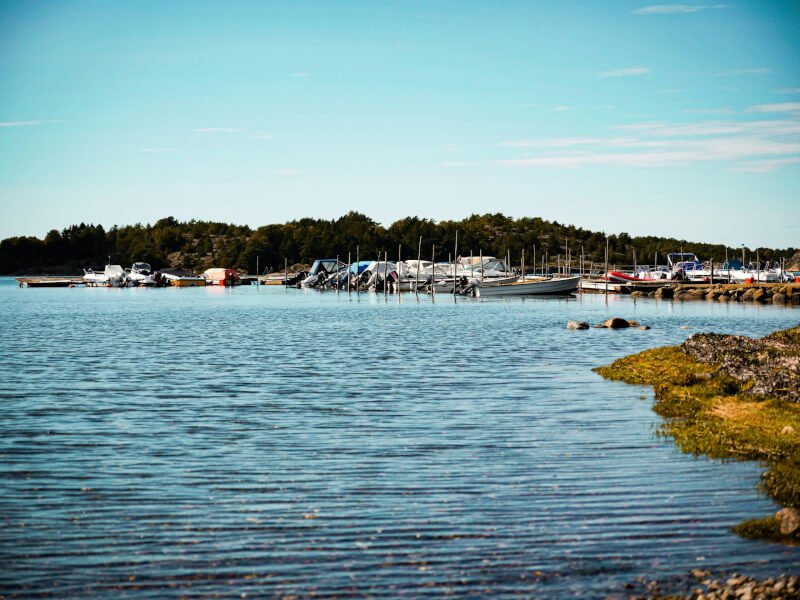
Food Safety
Properly storing food is essential to prevent wildlife encounters and keep your campsite clean. Store all food in sealed containers to prevent animals from being attracted to your campsite. Invest in a bear-resistant food storage container or hang your food in a bear bag if you’re camping in bear-prone areas. Keep your cooking area clean by wiping down surfaces and disposing of food scraps properly.
Disposing of trash and food waste is equally important for food safety and to minimize your impact on the environment. Make sure to pack out all your trash and dispose of it in designated bins or take it home with you. Leaving trash behind not only attracts wildlife but also damages the natural beauty of the campsite. Always follow the principle of “leave no trace.”
When camping, it’s important to be aware of local wildlife and their behaviors. Research the area you’ll be visiting to learn about any potential wildlife encounters you may have. Keep a safe distance from wildlife and never approach or feed them. Maintain a clean campsite and properly store food to avoid attracting animals. By respecting wildlife, you can ensure a safe and enjoyable camping experience.
Water Safety
Water safety is essential during camping trips, especially when it comes to consuming water. Boiling or treating water before consumption is crucial to avoid waterborne illnesses. Even if the water source appears clean, it’s best to err on the side of caution and treat it. Boiling the water for at least one minute or using water purification tablets are effective methods for ensuring its safety.
In addition to treating water, make sure to pack sufficient drinking water for your camping trip. The amount of water you’ll need depends on factors such as the duration of your trip, the number of people in your group, and the availability of water sources at the campsite. Stay hydrated throughout your trip and encourage others in your group to do the same.
Practicing sanitary practices for personal hygiene is crucial to prevent the spread of bacteria and maintain good health while camping. Use biodegradable soap and warm water to wash your hands, dishes, and utensils. Dispose of wastewater properly, following the campground’s guidelines. Keeping a clean campsite and practicing proper hygiene will help prevent illnesses during your camping trip.
While it might be tempting to cool off in a nearby lake or river, it’s important to avoid swimming in unfamiliar or unsafe waters. Fast currents, hidden obstacles, or waterborne diseases can pose serious risks. Before swimming, research the specific body of water to ensure it’s safe for recreational use. If swimming is allowed, follow any posted guidelines or warnings provided by park authorities.
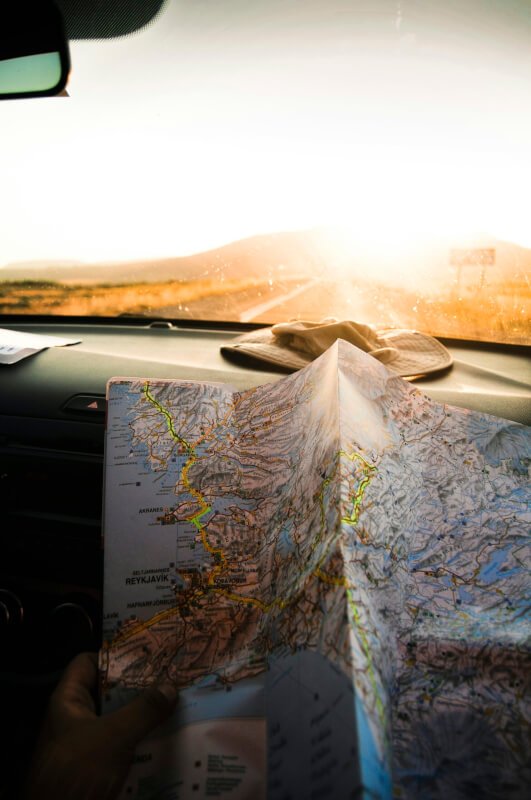
Wildlife Safety
Encounters with wildlife can be an exciting part of camping, but it’s important to approach them with caution and respect. Research the local wildlife and their behaviors before your trip to understand how to safely interact with them. Keep a safe distance from wildlife and never attempt to touch or feed them. Observe animals from a distance using binoculars or a telephoto lens.
Properly storing food is essential to avoid attracting wildlife to your campsite. Animals are naturally drawn to the smell of food, so make sure to store all food and scented items securely. Invest in a bear-resistant food storage container or hang your food in a bear bag if necessary. By preventing wildlife from accessing your food, you can minimize the risk of encounters and ensure everyone’s safety.
In the event of an encounter with wildlife, it’s important to know how to react. Stay calm and avoid sudden movements or loud noises. Back away slowly without turning your back on the animal. Give the animal plenty of space and never try to approach or scare it away. If the animal becomes aggressive or poses an immediate threat, make yourself appear larger by raising your arms and speaking firmly.
Emergency Preparedness
Being prepared for emergencies is crucial for any camping trip. Carrying a well-stocked first aid kit is essential for treating minor injuries and illnesses. Make sure your first aid kit includes items such as bandages, antiseptic wipes, adhesive tape, and pain relievers. Familiarize yourself with the contents of the kit and how to use them before leaving for your trip.
Learning basic first aid skills can make a significant difference in emergency situations. Take a first aid course or familiarize yourself with basic techniques, such as CPR and treating common camping injuries. Knowing how to respond in case of emergencies can potentially save lives and minimize the impact of an incident.
Know the location of the nearest medical facility to your campsite. Research hospitals or urgent care centers in the area and keep their contact information readily available. In case of serious injuries or medical emergencies, knowing where to seek medical assistance will save valuable time and ensure the best possible care.
Having emergency contact numbers on hand is essential in case of any unexpected incidents. Keep a list of emergency contact numbers, including local authorities, park rangers, or emergency services. Make sure your phone is fully charged and bring a portable charger if necessary. By being prepared and having access to emergency contacts, you can handle unexpected situations promptly and efficiently.
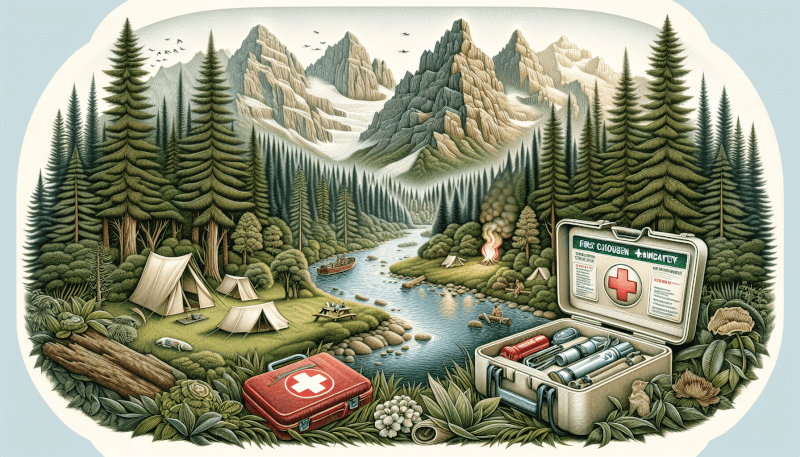
Navigation and Orientation
Navigating through the wilderness is an important skill for any camper. Carry a detailed map of the area you’ll be camping in, highlighting important landmarks and trails. Study the map and familiarize yourself with the terrain before setting out. Understanding the topography and features of the area will help you navigate with confidence.
Using a GPS device or compass is a reliable way to ensure you stay on the right track. GPS devices can provide accurate location information and help you navigate through unfamiliar territory. Alternatively, a compass paired with a map can serve as a reliable navigation tool. Make sure to bring extra batteries or power banks to keep your devices charged throughout your trip.
Marking your campsite with easily recognizable landmarks is crucial for finding your way back. Use natural features like distinct trees, rocks, or bodies of water as reference points. You can also create your own markers, such as stacking rocks or tying brightly colored ribbons around trees. Being able to locate your campsite easily will prevent getting lost and reduce unnecessary stress.
Staying on established trails is vital for preserving the environment and for your own safety. Straying from designated trails can lead to damaging delicate habitats or getting disoriented in unfamiliar terrain. Always follow any signs or markers indicating the proper paths to take. Respect protected areas and stay on established trails to minimize your environmental impact.
Leave No Trace
Practicing Leave No Trace principles is essential for minimizing your impact on the environment and preserving the natural beauty of your campsite. Minimize your impact by using designated campsites and facilities whenever possible. Avoid trampling vegetation and be mindful of fragile ecosystems, especially in sensitive areas.
Properly disposing of waste is crucial for preserving the cleanliness of the campsite. Pack out all trash and dispose of it in designated bins or take it home with you. Do not bury or burn trash, as this can harm the environment and wildlife. Consider bringing biodegradable soap and use it sparingly to reduce the impact on natural water sources.
Respecting wildlife and vegetation is an important aspect of Leave No Trace camping. Observe wildlife from a distance and never attempt to touch or feed them. Avoid picking flowers or damaging vegetation. Leave natural objects or artifacts as you found them, so that future campers can enjoy the same experience.
Lastly, before leaving your campsite, make sure to clean up thoroughly and leave it in the same condition you found it. Remove any personal items, debris, or signs of your presence. By leaving the campsite as you found it, you contribute to the preservation of natural areas and ensure that future campers can enjoy the same pristine environment.
In conclusion, a successful and safe camping adventure requires careful planning and consideration of various factors. Researching potential campsites, checking for accessibility, and considering weather conditions are all important aspects of campsite selection. Preparing for your trip by checking the weather forecast, creating a detailed itinerary, informing others of your plans, and packing essential safety gear is essential for a smooth camping experience. When setting up your campsite, choose level and stable ground, clear the area of hazards, and set up proper fire safety measures. Practice campfire safety, food safety, water safety, wildlife safety, and emergency preparedness throughout your trip. Be mindful of navigation and orientation, and always practice Leave No Trace principles to ensure a secure and memorable camping adventure.
